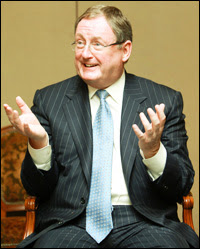Originally built in 1982, the gallery houses works from over 1,000 items in MFA’s Korean collection. “Our Korean collection really formed from the very beginning of the museum,” Malcolm Rogers, director of MFA, told The Korea Times after his lecture on Thursday.
Rogers came to Korea to speak about MFA’s global outreach programs at a forum hosted by the Korea Foundation. Jane Portal, the Matsutaro Shoriki chair for the Art of Asia, Oceania, and Africa at MFA, accompanied him for the occasion.

Considered as one of the finest in the West, MFA’s Asian art collection started when three men from Boston traveled to Japan in the late 18th century and brought back Buddhist paintings. Among them were pieces from the Goryeo Kingdom (936-1332) and Joseon Kingdom (1392-1910). The collection also accrued porcelains and ceramics that Chareles Bain Hoyt, a railroad heir, donated in 1950.
Portal who oversees the Asian collection has been acquiring screens and contemporary ceramic creations. “People are familiar with Japanese screens but Korean works are not so well known. I wanted to show that Korea also produced screens,” she said. By displaying works of modern day potters such as Shin Sang-ho and Lee Eun-jin, Portal hopes to show how they have transformed the traditional techniques.
“Portal is an expert and well connected, but we don’t have a curator in Korean art yet. We’d love to receive funding for that one day,” said Rogers. The museum which had about 1.2 million visitors last year, funds itself through three channels — endowment, fundraising and admission. The museum has about 80,000 members who pay annual subscription fees. The budget for this year is $75 million.
The government contributes by making gifts deductible, which gives donors tax breaks.
Having served as deputy director and deputy keeper at the National Portrait Gallery in London, he explains the difference in the funding system between the two countries affects the public’s attitude. In Britain, the government supports museums and as a result, the general admissions are often free. “I think it makes the public take you (museums) for granted, where as in America, people feel that they are acquiring something of value if they are paying.”
Surrounded by schools like Harvard, MIT and Boston University, MFA is developing programs to reach students. Last year’s College Night, an annual event that invites faculty members and students free of charge to enjoy shows, drinks and music at the museum, attracted 6,000 visitors.
The Massachusetts schools pay annual fees to allow their students to visit the museum for free. The subscription fee varies with the size of the student body. Recently, private philanthropies from New Hampshire and Maine offered to organize funds. This will allow students from the states to visit the museum for free as well.
MFA also fosters a group of young professionals to be the leaders of their society. Members of the Art Council learn about art collecting, meet donators and attend various functions.
Since he took the position in 1994, Rogers has strived to make the institution more accessible. He extended the museum’s opening hours in 1995; MFA is now open seven days a week. “I believe museums exist for people.” He has also been focusing on globalization. In 1999, Rogers helped launch the Nagoya/Boston Museum of Fine Arts in Nagoya, Japan.
“MFA is encyclopedic; we really try to represent world culture in all times.”

No comments:
Post a Comment